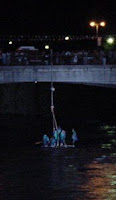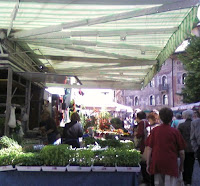
As you stroll along the Adige River on the tree-lined paths between Trento's two main bridges, Ponte San Giorgio and Ponte San Lorenzo, you notice the swift, but gentle current, while cyclists pass by, people walk their dogs, and fishermen below wait for a catch. Colorful buildings line the, at times, busy streets. The monument on Dos Trento and the 13th century church, la chiesa di S. Apollinare, come into view as the cable car begins its quick ascent towards Sardagna from the station near the San Lorenzo bridge.

Though most days are about as pleasantly uneventful as this, keep an eye out for the unusual. Perhaps a shepherd may lead a flock of sheep across the city streets to the edge of the river to be watered, or the vigili del fuoco may conduct a rescue drill, moving up and down the river in a rubber dinghy.

At the end of June, this stretch of the river comes alive during the Festa di San Vigilio. Local teams float downriver in costume on wooden rafts, cross several times, and, reminiscent of a Survivor-style
immunity challenge, pause at certain points to accomplish particular tasks, including hitting a target with an arrow, putting a ring on a large duck, throwing a ball into a net, and finally, ringing a buzzer mounted on the bridge. The winning team completes every task (not many do in the swift current) in the shortest amount of time possible.



.JPG) ur needs, there's something for you at the Thursday market.
ur needs, there's something for you at the Thursday market.